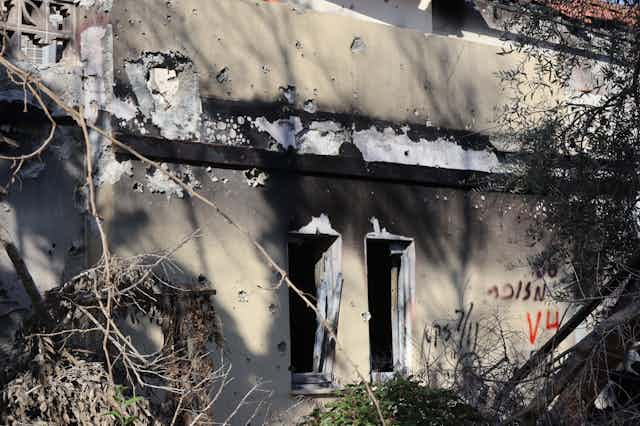On the morning of Oct. 7, 2023, Hamas orchestrated a series of attacks on Israeli communities. This was the deadliest attack Israel had experienced since the state was established in 1948. An estimated 1,200 people were killed, hundreds were taken hostage and approximately 30,000 displaced.
As an associate professor of disaster and emergency management who studies terrorism, I travelled to Kibbutz Be'eri in February, where I had the opportunity to bear witness to survivors of the atrocity.
As a matter of respect for Israel’s dead, survivors and remaining hostages, a certain moral obligation seems clear: atrocity requires representation. Bearing witness means taking on a burden of responsibility to observe and document.
Bearing witness can serve multiple purposes. Attempting to understand the toll of the conflict on survivors of violence and documenting atrocity to call attention to the criminality of terrorism can all be results of bearing witness.
I was embedded in an environment that was still in disaster response mode. Conducting research in communities affected by the attack required delicate manoeuvreing due to the precarious security situation and general unpredictability.
To navigate such challenges, my co-ordination with organizations having intimate local knowledge of ground conditions was of utmost importance. Arrangements for bearing witness were facilitated by the American Healthcare Professionals and Friends for Medicine in Israel (APF), who organized the Israel Solidarity Mission, which I participated in.
I made field observations at Kibbutz Be’eri at a point in time 130 days after the massacre. When Hamas attacked, the ensuing devastation at Be'eri resulted in 112 residents of the kibbutz being murdered.

Among those killed at Be'eri was Vivian Silver, a prominent Canadian Jewish humanitarian originally from Winnipeg.
Read more: Israel-Hamas war: will the murder of peace activists mean the end of the peace movement?
Physical ruins
One observation that repeatedly stood out was arson. Observable burn scorch marks surrounding windows of bedrooms and safe rooms were apparent. Exterior walls of dwellings were pockmarked by automatic weapon fire. Interior walls of dwellings were scarred with blast effects from anti-personnel grenades.
The locations and characteristics of physical evidence of ruins, directly corresponded with descriptions of deaths as remembered by survivors and other third-party analysis describing the mechanics of how the massacre took place.
Overall, my observations — made on a neighborhood-by-neighborhood basis in Be'eri — indicated the attackers had no apparent tactical objectives to their running amok, other than killing and taking hostages.
The fate of evacuees
Intertwined with the sites of atrocity are locations where response is taking place. Hotels serve as shelters for those who cannot yet return. Approximately five months after the Oct. 7 attacks, 135,000 Israelis remain displaced.
In meeting with emergency management officials at the city of Ramat Gan, east of Tel Aviv, I learned that providing emergency social social services to evacuees has become a new responsibility for the city’s disaster workers. In late February, 15,100 evacuees still reside in the Tel Aviv metropolitan area.

For evacuees, their sense of security has been shattered, and their responses to the trauma they witnessed on Oct. 7 stretches their capacity to cope. Whether and how they can return to their homes in the Gaza Envelope is a decision fraught with emotion.
The coming months will be a pivotal point for evacuees. The government has announced two options. As of March 1, evacuees may start to return home with the approval of the Israel Defense Forces. Or, if they are not ready to return, they can receive funding to remain in hotels until July 7.
The suffering of others
On the five-month anniversary of the attacks, attempting to digest and analyze recent events in Israel remains challenging, given the depth of the tragedy. Relevant questions are raised in Regarding the Pain of Others, in which American writer Susan Sontag asks: “What does it mean to care about the sufferings of others far away?”
After the visceral experience of bearing witness to atrocity by setting two feet on the ground at Be'eri, I am left with more questions than answers concerning what it means to care about far away suffering. After the more mundane experience of witnessing evacuees having an uncertain future living in hotels, I am thinking about how local disaster response actions play into national crises.
For survivors in Israel, the displacement and trauma are ongoing and it will take the time that it takes for their lives to normalize. A timeline cannot be put on the social and psychological repair of their lives. Experiences of survivors and evacuees should inform emergency measures by suggesting the timeline for evacuees to return home should remain as flexible as possible.
Edward Snowden, a graduate of the Master’s in Disaster and Emergency Management Program at York University who specializes in mass casualty management, contributed his observations from Israel.

